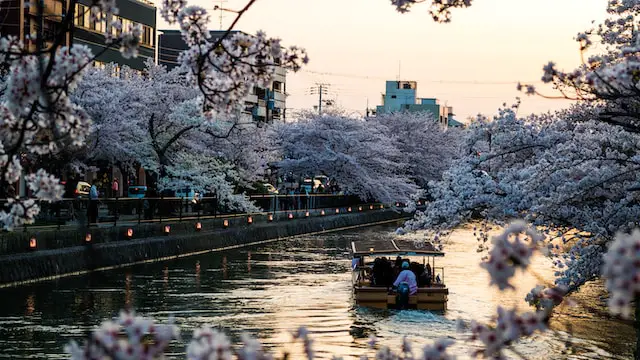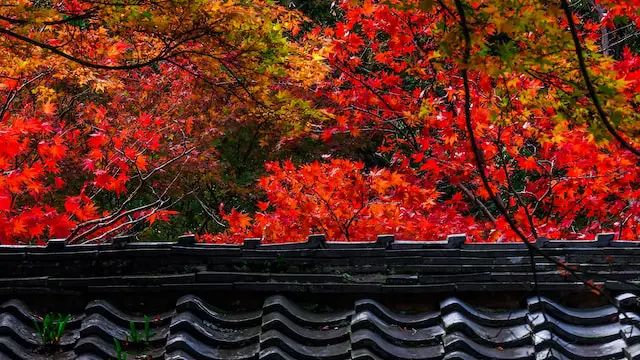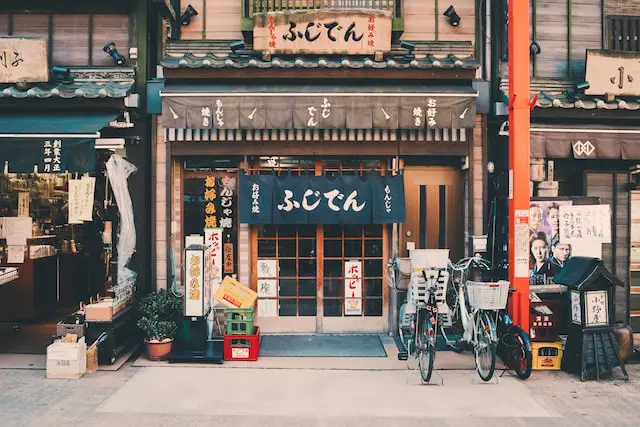Kyoto, the city that was once the heart of ancient Japan, offers an alluring blend of traditional charm and scenic tranquility. Known for its rich historical heritage and stunning beauty, it’s no wonder that solo travel to Kyoto is experiencing a significant surge. The city is bursting with cultural gems – from the opulent imperial palaces to the serene Zen gardens. It’s a dream come true for those seeking solitude and a blissful retreat from the hustle and bustle of everyday life.
However, exploring this ethereal city can be overwhelming, primarily due to its vast array of attractions. That’s where a comprehensive Kyoto travel guide comes in handy. A well-researched plan not only simplifies your journey but also helps you uncover the hidden treasures of the city, maximizing your Kyoto travel experience manifolds. Whether you’re a history buff, nature lover, or a foodie at heart, Kyoto has something special in store for you. So step into your comfort zone, soak in the city’s mesmerizing allure, and make the most of your solo travel in Kyoto.
Exploring Kyoto’s Temples and Shrines
One of the quintessential experiences of solo travel Kyoto is immersing yourself in the serene atmosphere of its numerous holy sites. They represent the perfect fusion of ancient tradition, mesmerizing aesthetics, and tranquility that solo travelers often seek.
The Kinkaku-Ji, or the Golden Pavilion, should undoubtedly mark the start of your exploration. This landmark temple coated in glistening gold leaf stands above a reflective pond, creating enchanting scenes that shift with every change of season and light.
No Kyoto travel guide would be complete without mentioning the Fushimi Inari Shrine. Known for its iconic red torii gates that create a mesmerizing path up the Inari Mountain, this sacred place offers a meditative journey—especially when explored during less crowded times.
While these famous sites draw crowds, your solo travels also offer a golden chance to find your quiet corner in the city. Seize the opportunity to explore the lesser-known and equally enchanting quiet temples in Kyoto. Nestled in the city’s historic quarters, temples like the Honen-in and Nanzen-ji promise a peaceful and contemplative atmosphere away from the bustling crowds.
Remember, each temple or shrine in Kyoto possesses its own charm and story. Absorbing their tranquility, marveling at their intricate architecture, and learning about their rich history amount to memories that will last you a lifetime. Delight in everything at your own pace to make the most of your solo journey through the city.
Teahouse Experiences in the Geisha District
Kyoto’s entertainment quarters, especially the famed Gion district, are the city’s beating heart, pulsating with age-old traditions. A labyrinth of narrow streets, lined with traditional wooden machiya houses, gives this district a distinct charm that captivates solo travelers.
Intricately bound to Kyoto’s cultural heritage, the Gion district is recognized worldwide for its prominent geisha culture. As a solo traveler, strolling through these historic lanes might lead to an encounter with a geisha or maiko (apprentice geisha), a truly special experience to treasure.
While solo travel in Kyoto promises countless enchanting experiences, indulging in a Japanese tea ceremony stands out as an absolute must. This meditative ritual of preparing and serving matcha, a powdered green tea, is steeped in spiritual significance and allows participants to embrace the heart of Japanese hospitality and its profound concept of Ichigo Ichie – treating every encounter as a once-in-a-life time event.
For visitors wishing to delve deep into Kyoto’s geisha culture and the aesthetics of Zen, a visit to a traditional teahouse, or ochaya, is recommended. In these establishments, visitors will discover the aesthetic beauty of wabi-sabi, embraced simplicity, and rusticity – just the kind of tranquil ambiance solo travelers often seek.
Your journey through Gion district and its teahouse culture wouldn’t be complete without treating your senses to enchanting melodies of the shamisen or the captivating traditional dance movements of a maiko. These unique experiences will leave an indelible imprint on your Kyoto journey.
So, when in Kyoto, immerse yourself in a captivating teahouse experience, treat your senses to a warm cup of tea, and let the Geisha district transport you back to the city’s rich past.
Bamboo Forests and Zen Gardens
The natural beauty of Kyoto is displayed in its charming bamboo forests and calm Zen gardens, making them an obligatory visit for solo travelers in search of serenity and picturesque sceneries.
Immerse yourself in a different world at the Arashiyama Bamboo Grove, where towering bamboo stalks create a serene and otherworldly path. The rustling of leaves and the soft crunch underfoot supplies a tranquility that is often sought by solo travelers. Early morning visits provide a quieter experience, to truly soak up the magic of this renowned grove.
Beyond the Bamboo Grove, Kyoto’s Zen gardens are an illustration of the minimalistic beauty inherent in Japanese design. Framed by natural landscapes, these gardens encapsulate the philosophical ideals of Zen Buddhism and reflect the tranquil side of Kyoto.
The famous Ryoan-ji Temple hosts one of the world’s most sublime and enigmatic Zen gardens. Comprising of finely raked gravel and 15 carefully placed rocks, it evokes a depth of contemplation perfect for the individual explorer.
Leaving the city into the rural setting, the garden of the Moss Temple, officially known as Saiho-ji, is another Zen marvel. To fully appreciate its carpet of moss and tranquil pond, it is advisable to visit after a rainfall, when the hues are at their most vibrant.
Sole adventures into Kyoto’s nature nurture a sense of peace and instill a deep appreciation for the harmonious union of man and nature in Japanese aesthetics.
The Philosopher’s Path Walk
Immersing oneself in the serene beauty of Kyoto is never more fulfilling than while taking a solitary stroll down the storied Philosopher’s Path. Named for the eminent Japanese philosopher Nishida Kitaro who frequently took respite in this quiet walk, the path exudes an aura of tranquility and contemplation that makes it a sought-after experience for solo travelers in Kyoto.
Stretching about two kilometers long, the path meanders between Ginkaku-ji (Silver Pavilion) and Nanzen-ji temple. It is fringed by hundreds of cherry trees that turn the path into a sweet-scented tunnel during sakura season. Meanwhile, during autumn, the foliage turns into a riot of fiery hues, reflecting on the canal beside the path and creating a spectacle worthy of a painting. No matter the season, this path has a charm of its own, a testament to the many breathtaking scenic walks in Kyoto.
Tips for visitors: Sakura season (late March to early April) and Autumn (November) are the best times to embark on this spiritual journey. You may want to start your walk early morning for a peaceful, contemplative solo trip, devoid of large crowds. Along the way, you’ll come across small temples, quaint shops, and lovely cafes where you can refresh and enjoy the local flavors.
Solo traveling necessitates a journey inward as much as it involves exploring new terrains. And there’s no place better than the Philosopher’s Path for a traveler to connect with nature, history, and self. Happy journeying!
Food and Dining Solo in Kyoto
Embarking on a solo travel to Kyoto is not complete without diving into the city’s rich culinary landscape. Kyoto’s food scene is as diverse and captivating as its scenic beauty, catering to solo-diners with open arms.
Kyoto’s eccentric mix of dining establishments will surely please your palate. From bustling street food stalls offering a variety of quick bites to high-end restaurants serving a intricate multi-course Kaiseki meal, the options are seemingly endless.
A must-visit is the esteemed Nishiki Market, also known as Kyoto’s kitchen. It is a colorful mecca for food lovers, offering a myriad of vibrant, fresh food ranging from local vegetables to fresh seafood. Don’t hesitate to explore the multitude of stalls as a solo traveler – the market’s friendly shopkeepers are always ready to guide you through their offerings.
For those desiring a more refined dining experience, sample a traditional Kaiseki meal, a multi-course dinner that mirrors Kyoto’s beautiful seasons and takes you on a journey through refined flavors and textures of Japanese cuisine. Many establishments welcome solo diners and even offer counter seating so you can watch as the chef meticulously crafts each dish.
Whether you’re relishing street food in the lively Nishiki Market or enjoying a sophisticated Kaiseki meal, Kyoto’s cuisine offers both variety and a unique dining experience for every solo traveler. Don’t shy away from this gastronomical adventure – it’s an integral part of your Kyoto journey.
Traditional Crafts and Shopping
Immersing yourself in Kyoto’s vibrant shopping scene is a rewarding endeavor during your solo travel Kyoto journey. The city is rich with traditional craftsmanship that ranges from intricate tea utensils to exquisitely hand-woven textiles.
Start your exploration at the historic Nishiki Market. Here, you can delve into the treasure trove of local crafts and food products, making it an ideal place to shop not only for yourself but for unique, memorable Japanese souvenirs.
For those passionate about the Kyoto’s historical tea culture, a visit to Janomeya Hanamachi is a must. This shop specializes in tea utensils and pottery, selling the hand-crafted, artistic tools required for a Japanese tea ceremony.
Textile enthusiasts should head to Orinasu-kan – a museum-cum-shop that beautifully preserves Kyoto’s legacy of textile artistry. You can see artisans at work, creating magnificent hand-woven fabrics with techniques that have been passed down through many generations. The produced textiles carry the signature Kyoto aesthetic – a delicate balance of simplicity and sophistication.
If you’re interested in Kyoto crafts, Ando Shippo offers a glimpse into the ancient craft of cloisonné – a form of enamel ware that Kyoto artisans have perfected over centuries. The intricate designs on their vases and jewelry pieces are the results of meticulous work and unparalleled skill.
As an enriching part of your Kyoto travel experience, shopping in Kyoto is more than just a retail activity—it is a tangible way to connect with the city’s historic culture and arts. Embracing this will further enhance the depth of your solo adventure in the city.
Conclusion
There is no doubt that Kyoto beckons the solo traveler with its intoxicating blend of ancient and modern Japan. From the splendid Kyoto temples to the tranquility of the Arashiyama Bamboo Grove, this city invites you to live in the moment, breathe in the scent of centuries-old timber and stone, and soak in its scenic beauty.
Every step you take in the serene geisha district of Gion is a step back in time, and the traditional Japanese tea ceremony offers a sublime pause from the rush of modern life. No solo Kyoto travel experience would be complete without an introspective walk along the Philosopher’s Path, especially during the breathtaking cherry blossom or fall seasons.
For the food aficionados, street stalls, traditional markets like Nishiki, and high-end establishments offering Kaiseki meals boast a culinary culture that not only tolerates but also celebrates solo dining. And when it comes to shopping and local crafts, what better mementos of your journey than pottery, tea utensils or delicately woven textiles?
Savvy solo travelers know the importance of slowing down and truly embracing the moment, and Kyoto provides just the perfect opportunity to do so. As you venture through the alleyways, temple grounds, and serene landscapes, embrace every aspect of solitude and derive joy from your own company, you turn your journey into a profound exploration of self-discovery—within the enchanting corners of the world, and within yourself.
May your solo travel in Kyoto become a reflection of the city’s own attitude—always evolving, yet eternally bound to its roots.




